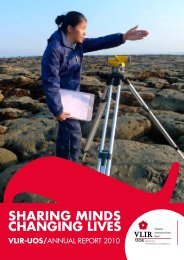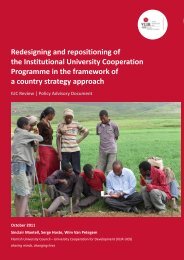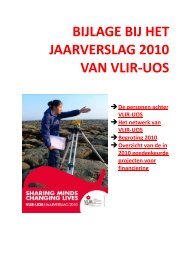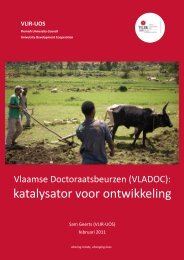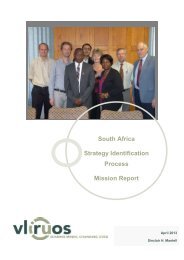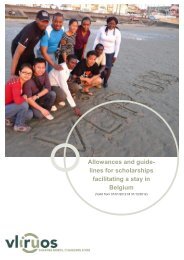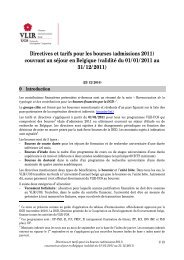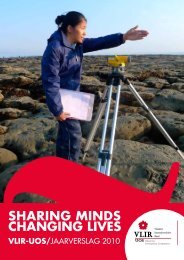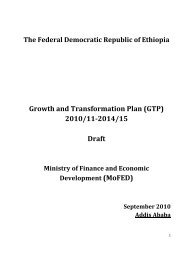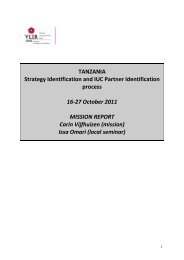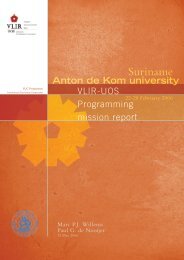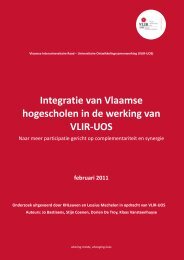Education Sector Development Program - VLIR-UOS
Education Sector Development Program - VLIR-UOS
Education Sector Development Program - VLIR-UOS
You also want an ePaper? Increase the reach of your titles
YUMPU automatically turns print PDFs into web optimized ePapers that Google loves.
<strong>Education</strong> <strong>Sector</strong> <strong>Development</strong> <strong>Program</strong> IV<br />
regions of the country has played an important<br />
role in the increment of enrolments. The GER<br />
(grades 1-8) which was 23.3% and 20.9% in<br />
Somali and Afar in the year 2004/05 has grown,<br />
according to the regional reports, to 58% and<br />
63.8%, respectively, in 2008/09.<br />
But the enrolment rates of the emerging regions<br />
are still low when compared to the average of<br />
the country. Thus, introducing new alternative<br />
modalities and strengthening the existing ones<br />
will be continued during the ESDP IV to access<br />
equitable quality education for pastoral and<br />
agro pastoral region children. Boarding schools,<br />
low cost pensions, mobile schools etc. should<br />
be introduced and strengthened. Attention will<br />
have to be given to their design to facilitate the<br />
continuation of studies for learners who have<br />
completed ABE and find it difficult to join formal<br />
schools. Transforming the ABE centers to<br />
formal/regular schools in the areas where the<br />
communities are relatively settled, expanding<br />
and up-grading the existing formal schools,<br />
constructing new 1st and 2nd cycle primary<br />
schools and providing the schools with basic<br />
facilities will also be given special attention in<br />
ESDP IV.<br />
In addition, organizing different support<br />
mechanisms, such as tutorial programs, school<br />
feeding programs, material and financial support,<br />
scholarship programs for the indigenous children<br />
(both girls and boys) and the vulnerable will be<br />
emphasized in ESDP IV to strengthen the internal<br />
efficiency of the schools in the emerging regions.<br />
Furthermore, strengthening the capacity of<br />
officials and experts working at REB and WEO<br />
by organizing different capacity development<br />
programs, up-grading the academic level of<br />
facilitators and teachers, as well as, REB and<br />
WEO officials and experts of the emerging regions<br />
by arranging: in-service summer programs,<br />
distance programs, etc. will intensively be<br />
continued during the ESDP IV.<br />
Main challenges<br />
• Vulnerability of pastoral and agro<br />
pastoral regions to repeated<br />
drought and food shortage which<br />
in turn forces students to drop out<br />
of school,<br />
• Communities’ low level of<br />
awareness on the importance of<br />
education and reluctance to send<br />
girls to school,<br />
• Impact of mobility and low density<br />
of population that has made the<br />
building of infrastructures and<br />
social services difficult<br />
• Inability of addressing the<br />
education needs of pastoralists<br />
through formal schools alone,<br />
• Lack of capacity within educational<br />
management bodies in particular<br />
to collect and analyze data and to<br />
mobilize the community for the<br />
development of the education<br />
sector,<br />
• Inability to deliver primary<br />
education in the vernacular<br />
language of pastoral and agropastoral<br />
regions, (specially Afar),<br />
• Acute shortage of teaching<br />
learning materials and teaching<br />
aids in primary schools of pastoral<br />
regions,<br />
• High gap of access to primary<br />
education between the emerging<br />
regions (Gambella, Somali and<br />
Afar regions) and other regions,<br />
• Limited transition from ABECs<br />
to formal/regular schools, due<br />
to the lack and distance of Cycle<br />
2 (Grades 5-8) primary schools,<br />
2. Expected program outcomes<br />
❚<br />
❚<br />
❚<br />
Emerging regions children’s<br />
(especially indigenous children)<br />
access to primary education<br />
increased, through continuous<br />
expansion of regular schools and ABE<br />
centers,<br />
The gap between the emerging<br />
regions and other regions in access<br />
to equitable quality education<br />
reduced, by giving special support to<br />
the education of emerging regions’<br />
children (both female and male),<br />
Capacity of <strong>Education</strong>al management<br />
bodies at various levels and<br />
facilitators / teachers strengthened<br />
Key outcome indicators / targets:<br />
Drop-out rate in the first cycle of primary schools<br />
and ABE centers decrease to 1% for both girls<br />
and boys by 2014/15,<br />
The repetition rate in primary education will<br />
decrease to 1% for both girls and boys by 2014/15,<br />
45



